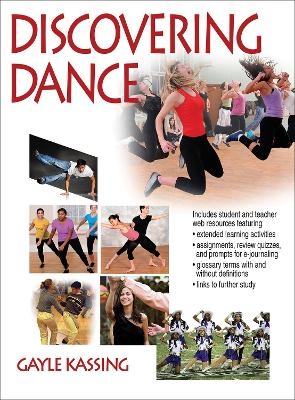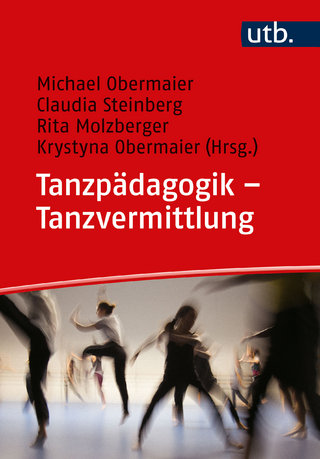
Discovering Dance
Human Kinetics (Verlag)
978-1-4504-6886-2 (ISBN)
- Titel erscheint in neuer Auflage
- Artikel merken
Discovering Dance is the ideal introductory text for students with little to no dance experience. Teachers can adapt this course to meet students where they are, whether they are new to dance or already have some dance experience.
The material helps students consider where movement comes from and why humans are compelled to move, grasp the foundational concepts of dance, and explore movement activities from the perspectives of a dancer, a choreographer, and an observer. The result is a well-rounded educational experience for students to build on, whether they want to further explore dance or choreography or otherwise factor dance into college or career goals.
Discovering Dance will help students in these ways:
• Meet national and state standards in dance education and learn from a pedagogically sound scope and sequence that allow them to address 21st-century learning goals.
• Discover dance through creating, performing, analyzing, understanding, responding to, connecting to, and evaluating dance and dance forms.
• Step into a flexible dance curriculum that is appropriate for one or more years of instruction.
• Build on their dance experience, whether they want to further explore dance or choreography or otherwise factor dance into college or career goals.
• Use student web resources to enhance their learning.
The book is divided into four parts and 16 chapters. Part I focuses on the foundational concepts of dance and art processes, wellness, safety, dance elements, and composition. Part II delves into societal facets of dance, including historical, social, folk, and cultural dance. In part III, students explore dance on stage, including ballet, modern dance, jazz dance, and tap dance, and also examine aspects of performance and production. Part IV rounds out the course by preparing students for dance in college or as a career and throughout life.
Each chapter helps students
• discover new dance genres;
• explore dance genres through its history, artists, vocabulary, and significant works;
• apply dance concepts through movement, written, oral, visual, technology, and multimedia assignments, thus deepening their knowledge and abilities;
• enhance learning by completing in each chapter a portfolio assignment; and
• use the Did You Know and Spotlight elements to expand on the chapter content and gain more insight into dance artists, companies, and events.
Learning objectives, vocabulary terms, and an essential question at the beginning of each chapter prepare students for their learning experience. Students then move through the chapter, engaging in a variety of movement discovery, exploration, response, and research activities. The activities and assignments meet the needs of visual, auditory, and kinesthetic learners and help students explore dance through vocabulary, history, culture, creation, performance, and choreography.
This personal discovery is greatly aided by technology—including learning experiences that require taking photos; watching or creating short videos of dancers’ performances; creating timelines, graphs, drawings, and diagrams; and creating soundscapes.
Chapterrs conclude with a portfolio assignment or project and a chapter review quiz. A comprehensive glossary further facilitates learning.
In addition, some chapters contain Explore More elements, which trigger students to investigate selected dance styles on the web resource. These sections offer students insight into various dance genres and styles; for example, in the chapter on cultural dance, students can explore more about street dances, Mexican folkloric dance, African dance, Indian dance, and Japanese dance.
The online components further strengthen the book and enrich the students’ learning experience. These resources also help teachers to prepare for and manage their classes. Here is an overview of the resources:
Teacher Web Resource
• Learning objectives
• Extended learning activities
• Handouts and assignments that students can complete, save, and print to turn in
• Explore More sections of selected chapters to introduce students to additional social, folk, cultural, and contemporary dance styles
• Chapter glossary terms both with and without the definitions
• Chapter PowerPoint presentations
• Information on assessment tools
• Interactive chapter review quizzes
• Answer keys for handouts, assignment sheets, and quizzes
• Unit exams and answer sheets
• Video and audio clips for selected dance genres
• Web links and web search terms for resources to enhance the learning
• Additional teacher resources to support and extend the teaching and learning process (these resources include chapter learning objectives, enduring understanding and essential questions, chapter quotes, teacher-directed information to support teaching specific activities, and web links)
Student Web Resource
• Handouts and assignments that students can complete, save, and print to turn in
• Explore More sections of selected chapters to introduce students to additional social, folk, cultural, and contemporary dance styles
• Chapter glossary terms both with and without the definitions so students can test their knowledge
• Information on assessment tools
• Interactive chapter review quizzes
• Video and audio clips for selected dance genres
• Web links and web search terms for resources to enhance the learning
The availability of Discovering Dance as not only a print book but also an e-book and an interactive iBook enhances its ability to introduce students to the elements of dance and help them discover new talents, desires, and delights as they explore movement and dance.
Gayle Kassing, PhD, taught beginning ballet through advanced ballet for more than 25 years at four universities. Kassing earned a BFA in ballet and theater, an MS in modern dance, a PhD in dance and related arts, and an MAT in K-12 curriculum integrated with technology. She was the 2010 National Dance Association (NDA) Artist Scholar. She is a member of the National Dance Education Organization (NDEO). She is the author of History of Dance and Beginning Ballet and coauthor of Dance Teaching Methods and Curriculum Design. Kassing is an acquisitions editor at Human Kinetics.
Part I. Foundations of Dance
Chapter 1. Dance for All
Chapter 2. Safety, Health, and Wellness
Chapter 3. Elements of Dance
Chapter 4. Basics of Dance Composition
Part II. Dance in Society
Chapter 5. History of Dance
Chapter 6. Social Dance
Chapter 7. Folk Dance
Chapter 8. Cultural Dance
Part III. Dance on Stage
Chapter 9. Ballet
Chapter 10. Modern Dance
Chapter 11. Jazz Dance
Chapter 12. Tap Dance
Chapter 13. Dance as Entertainment
Chapter 14. Performance and Production
Part IV. Dance for Life
Chapter 15. College and Career Preparation
Chapter 16. Dance in Your Life
| Erscheint lt. Verlag | 23.5.2014 |
|---|---|
| Verlagsort | Champaign, IL |
| Sprache | englisch |
| Maße | 216 x 279 mm |
| Gewicht | 1293 g |
| Themenwelt | Sachbuch/Ratgeber ► Sport ► Tanzen / Tanzsport |
| ISBN-10 | 1-4504-6886-1 / 1450468861 |
| ISBN-13 | 978-1-4504-6886-2 / 9781450468862 |
| Zustand | Neuware |
| Haben Sie eine Frage zum Produkt? |
aus dem Bereich


